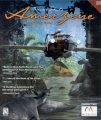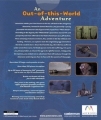Amerzone
First posted on 02 July 2009. Last updated on 20 January 2011.
The game is available at Microïds Shop.
This game is part of the Syberia Collection in the Adventure Classics series released in 2009 by Iceberg Interactive.
Syberia Collection
The compilation includes 3 games previously released by Microïds separately in 2001-2004:
- Amerzone
- Syberia
- Syberia II
I have long been a fan of Myst. While some critics have complained that it is ultimately little more than a glorified slideshow, many have found the whole of its presentation to be greater than the sum of its pictures. Myst is beautiful. Perhaps more importantly, Myst creates an experience of being a stranger in a strange land. The game encapsulates the feeling of personally exploring an impossible place. With the success of Myst, many imitators have jumped on the Myst bandwagon to promote the same kind of first person exploratory adventure. Amerzone (also known as Amerzone: The Explorer's Legacy), created by famed comic book artist Benoît Sokal, is an example of this derivative. While Amerzone lacks the lush graphics and challenging puzzles of Myst, it still manages to hold onto a spark of that sense of exploration that makes this kind of game so much fun to play.
Amerzone quickly identifies you as a journalist of some kind but gives you no further identity otherwise. An old man in a lighthouse tells you of the country of Amerzone, a mysterious land somewhere in Central America that has fallen on hard times since the disappearance of a large egg many years ago. This egg is the only hope of a race of mysterious and mystical white legless birds to return to Amerzone, and it is the old man's fervent belief that the land will not prosper until they do. Upon charging you with the quest to return the egg to the volcano where it is supposed to be found, the old man abruptly passes away. Searching the lighthouse reveals a journal and some notes on his trip to this country and a strange but versatile vehicle specifically built to travel to there. It is up to you to retrace the old man's journey to the volcano to restore the white birds and, hopefully, prosperity to the land.
The gameplay in Amerzone is typical of the adventure genre. You pass your cursor over objects in the game world, and the cursor changes to indicate a hotspot with which you can interact. Hand icon means you can grab or use, gears means you need to use an item on the spot, and (my personal favorite) an old fashioned ear horn means you can interact with a person. Other adventure games may use an icon like a speech bubble or a mouth for this action, but the ear horn is appropriate here because listening is all you can do in this game. The characters speak to you, apparently unconcerned that you are completely mute, and then they stop. Clicking on them again will usually elicit the exact same speech which, unfortunately, cannot be skipped.
The whole game is presented through the eyes of the nameless journalist. Each spot you stand allows you to look around in all directions freely. While providing a more realistic way of visualizing your surroundings, this departure from the slideshow format of Myst comes at a heavy visual cost. Amerzone has some pretty sceneries, but they are all heavily pixelated and pale in comparison. This is not to say the visuals are completely unsatisfying. Some of the hand drawn illustrations in the old man's journal are beautiful. The game as a whole, however, has a somewhat blocky look and feel which is even more apparent when compared to its contemporaries. This pixelization also has the unfortunate side effect of making some objects you need to pick up especially hard to see. It does not happen often, fortunately, but the pixel hunting is frustrating when it does.
The sounds in Amerzone are mid to high quality. The voice actors are not given much to do, but they handle well of what they are given. This is important, as the few individuals you meet only have a few lines with which to establish character. The small cast gives the game a feeling of loneliness and emptiness in many of its locations, but this may be deliberate as it fits the style of the game very well. Music is primarily used for brief cut scenes, often giving a cinematic flair as you travel between locations on your glider. The musical scores are effective but ultimately bland, and the game does well in only occasionally employing them. Most of the sounds come from the constant stream of background noises. From chirping birds and buzzing insects in the jungle, to industrial sounds in the lighthouse, to laps of water while standing on docks, the game supplies each location with subtle but appropriate ambiance. Since most of the visuals in the game are still images, these sounds give each environment a much needed boost of life and believability.
There are very few puzzles in Amerzone, and those that are there are ridiculously simple. Sometimes, advancing past an obstacle is as easy as finding a switch or turning a wheel in another location. Getting gasoline is as simple as finding a gas can and clicking it on a pump. By contrast, there is a puzzle which involves giving what seem to be random objects to a woman, and despite looking through the old man's notes and thoroughly investigating the area, I still have no idea what the logic is behind the objects I need to give to this person. This does not make the puzzle too much harder, though, as I have so few objects in my inventory at the time that figuring out which objects she wants is a simple affair.
Such is a common facet of the puzzles in Amerzone. The puzzles become a walk in the park simply because the game does not allow for many options. For example, at a certain point in the game, you are trapped in a jail cell—a dire situation for many adventurers. Yet, escape is as simple as finding a single object which you can pick up and use on a single hotspot in the cell. It does not matter if you do not understand how the solution may work. The sheer lack of choices makes solving the puzzle a breeze. Even after you escape the cell to a much larger area, there are still so few objects and hotspots to find that none of the puzzles can reach a truly challenging level. In all fairness, there are a handful of cleverer puzzles early on, but almost all of the rest follow this limited format. The developer seems to see the puzzles as mere additions to the storytelling rather than as the focus of an adventure game.
It is hard to say if Amerzone's policy of story before challenge is incorrect. After all, many adventure gamers play for the story as much as for the puzzles. Amerzone is a game that really gets the story right. It is minimalist, to be sure. There are only few characters along the way and not very much dialog with any of them. Still, the journey keeps me engaged the entire way. I feel a spark of excitement every time I manage to power up my glider for another leg of the trip. Walking in the footsteps of the old man, while comparing each stop on my journey to his description, gives every location in the game a fresh context. The graphics may be somewhat lackluster, but that does not make the world any less engaging to see some of the bizarre creatures which seem to be all that separate the fictional from the actual jungles.
Amerzone is a game that leaves me with mixed feelings. It is a game with many strengths but also many flaws. Some of the 7 chapters take less than 15 minutes to finish, and the satisfaction of solving the game is mitigated by the fact that it never taxes your mind much to do it. However, none of the game's shortcomings stop me from ever feeling that I am on a genuine adventure when playing this game, and in the end, that is really what this genre is all about (hence the name). Amerzone creates a visceral world, and it is a world that is well worth visiting.






